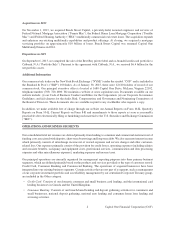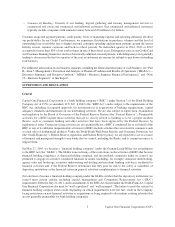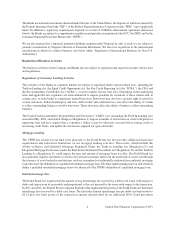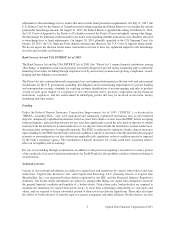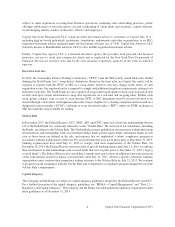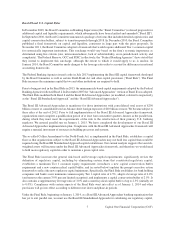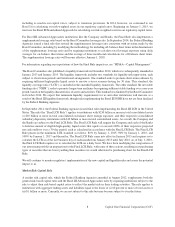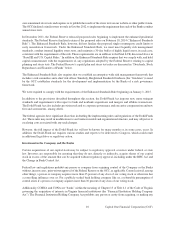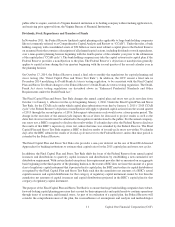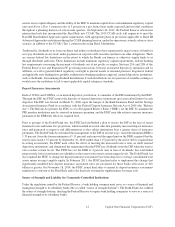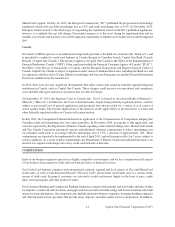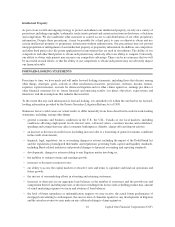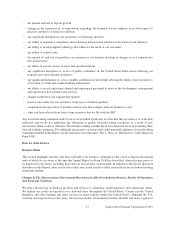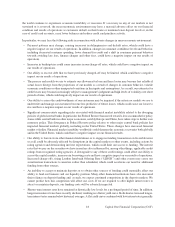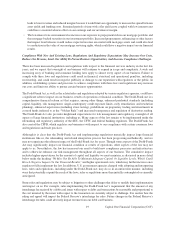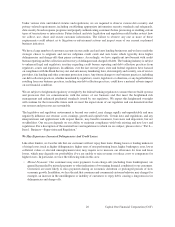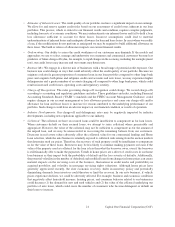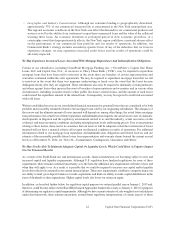Capital One 2014 Annual Report Download - page 34
Download and view the complete annual report
Please find page 34 of the 2014 Capital One annual report below. You can navigate through the pages in the report by either clicking on the pages listed below, or by using the keyword search tool below to find specific information within the annual report.used to assess capital adequacy and the ability of the BHC to maintain capital above each minimum regulatory capital
ratio and above a Tier 1 common ratio of 5 percent on a pro forma basis under expected and stressful conditions
throughout a planning horizon of at least nine quarters. On September 24, 2013, the Federal Reserve released an
interim final rule that incorporated the Final Rule into CCAR. The 2015 CCAR cycle will require us to meet the
Basel III Standardized Approach capital requirements, with appropriate phase-in provisions applicable to Basel III
Advanced Approaches institutions during the CCAR planning horizon, under the supervisory severely adverse stress
scenario, in addition to the CCAR’s Tier 1 common ratio using Basel I definitions.
Traditionally, dividends to us from our direct and indirect subsidiaries have represented a major source of funds for
us to pay dividends on our stock, make payments on corporate debt securities and meet our other obligations. There
are various federal law limitations on the extent to which the Banks can finance or otherwise supply funds to us
through dividends and loans. These limitations include minimum regulatory capital requirements, federal banking
law requirements concerning the payment of dividends out of net profits or surplus, Sections 23A and 23B of the
Federal Reserve Act and Regulation W governing transactions between an insured depository institution and its
affiliates, as well as general federal regulatory oversight to prevent unsafe or unsound practices. In general, federal
and applicable state banking laws prohibit, without first obtaining regulatory approval, insured depository institutions,
such as the Banks, from making dividend distributions if such distributions are not paid out of available earnings or
would cause the institution to fail to meet applicable capital adequacy standards.
Deposit Insurance Assessments
Each of CONA and COBNA, as an insured depository institution, is a member of the DIF maintained by the FDIC.
Through the DIF, the FDIC insures the deposits of insured depository institutions up to prescribed limits for each
depositor. The DIF was formed on March 31, 2006, upon the merger of the Bank Insurance Fund and the Savings
Association Insurance Fund in accordance with the Federal Deposit Insurance Reform Act of 2005 (the “Reform
Act”). The Reform Act permits the FDIC to set a Designated Reserve Ratio (“DRR”) for the DIF. To maintain the
DIF, member institutions may be assessed an insurance premium, and the FDIC may take action to increase insurance
premiums if the DRR falls below its required level.
Prior to passage of the Dodd-Frank Act, the FDIC had established a plan to restore the DIF in the face of recent
insurance losses and future loss projections, which resulted in several rules that generally increased deposit insurance
rates and purported to improve risk differentiation so that riskier institutions bear a greater share of insurance
premiums. The Dodd-Frank Act reformed the management of the DIF in several ways: raised the minimum DRR to
1.35 percent (from the former minimum of 1.15 percent) and removed the upper limit on the DRR; required that the
reserve ratio reach 1.35 percent by September 30, 2020 (rather than 1.15 percent by the end of 2016); required that
in setting assessments, the FDIC must offset the effect of meeting the increased reserve ratio on small insured
depository institutions; and eliminated the requirement that the FDIC pay dividends from the DIF when the reserve
ratio reaches certain levels. The FDIC has set the DRR at 2 percent and, in lieu of dividends, has established
progressively lower assessment rate schedules as the reserve ratio meets certain trigger levels. The Dodd-Frank Act
also required the FDIC to change the deposit insurance assessment base from deposits to average consolidated total
assets minus average tangible equity. In February 2011, the FDIC finalized rules to implement this change that
significantly modified how deposit insurance assessment rates are calculated for those banks with assets of $10
billion or greater. On November 18, 2014, the FDIC issued final rules to amend its deposit insurance assessment
regulation to conform to the Final Rule and to the final rule revising the supplementary leverage ratio.
Source of Strength and Liability for Commonly-Controlled Institutions
Under the regulations issued by the Federal Reserve, a bank holding company must serve as a source of financial and
managerial strength to its subsidiary banks (the so-called “source of strength doctrine”). The Dodd-Frank Act codified
the source of strength doctrine, directing the Federal Reserve to require bank holding companies to serve as a source of
financial strength to its subsidiary banks.
12 Capital One Financial Corporation (COF)


